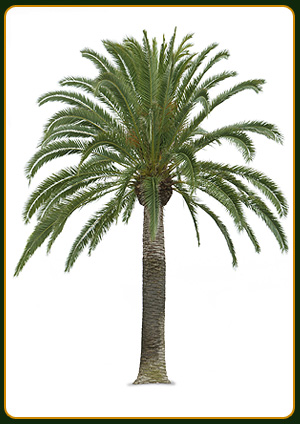Technical Data
Phoenix canarienis

Scientific / Latin name: Phoenix canarienis.
Common name: Canary Palm Tree, Phoenix, Canary Islands Palm Tree, Tamara.
Family: Arecaceae (previously Palmaceae).
Origin: Native to the Canary Islands (Spain).
Etymology: Phoenix comes from the Greek and refers to the country (Phoenicia) where the Greeks saw the first palm trees in ancient times.
Main features:This is a palm tree of real beauty because of its bearing, foliage and color of its fruits. It is one of the palm trees most cultivated in the world and is widely distributed in Africa, Americas, Europe and Asia. Its top can measure up to 10 m diameter and yields ample shade. It can reach a height of 20 m. and the trunk 1m in diameter. Its growth is slow. Its leaves are pinnate and arched, 5-6 m long, composed by 150-200 pairs of acuminate bright green leaves.
’Dyadic’ Palm Tree. Female and male flowers are produced by different individuals. The females produce big clusters of orange fruits. Tiny flowers, brownish yellow, in hanging inflorescences measuring more than 1 m that sprout in April and are followed by 2.5 cm ovoid fruits, quite similar to dates, golden brown, that only ripen in favorable climate conditions.
It can stand sea winds and if some leaves wither as a result it recuperates the new ones.
Cultivation: It is quite a rustic and resilient palm tree.
Light: It needs good sunlight.
Weather conditions: It can withstand cold temperatures down to -8ºC without much trouble. There were cases in which even -18ºC were recorded and acclimatized palm trees underwent only some frost biting of the leaves from which they recovered totally. These palm trees are particularly happy in mild Mediterranean climates.
Soil: No particular demands regarding the necessary type of soil.
Watering: It survives through droughts well. It will suffice with some moderate watering which shall be less in wintertime, as any excess of water might make the plant rot. It looks more majestic with the proper watering.
Transplanting: It does not resist transplanting so well as the dactyliferas or the Washingtonias and hence it is important to make a good ball of earth which shall be kept whole because if it crumbles it is quite probable that the palm tree will not take in its new location.
Multiplication: It multiplies by seed, also by seedlings or basal seedlings but less. The whole seed surface shall be carefully cleansed. Then these shall be left soaking for a week, the water being replaced almost every day. Finally, these seeds are sown in a container (a type of ‘Tupperware’ can be used) with the proper substrate and maintaining the humidity level. The container shall be placed in a warm environment. Any place would do in the summer season but some artificial heating shall be necessary in other times of the year, e.g., there are people who place the container on top of a computer if it is permanently on. Germination takes place in between 1 and 3 months. It takes only one month or one and a half months in the summer season.